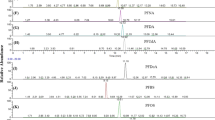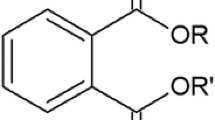Abstract
Polyfluoroalkyl phosphate mono-, di-, and tri-esters (mono-, di-, and triPAPs) are used to water- and grease-proof food packaging materials, and these chemicals are known precursors to perfluoroalkyl carboxylic acids (PFCAs). Existing analytical methods for PAPs lack sample clean-up steps in the sample preparation. In the present study, a method based on ultra performance liquid chromatography coupled to tandem mass spectrometry (UPLC/MS/MS) was developed and optimized for the analysis of mono-, di-, and triPAPs, including a clean-up step for the raw extracts. The method was applied to food samples and their PAP-containing packaging materials. The optimized UPLC/MS/MS method enabled the separation and identification of a total of 4 monoPAPs, 16 diPAPs, and 7 triPAPs in the technical mixture Zonyl®-RP. For sample clean-up, weak anion exchange solid phase extraction columns were tested. PAPs standard solutions spiked onto the columns were separated into a fraction containing neutral compounds (triPAPs) and a fraction with ionic compounds (mono- and diPAPs) with recoveries between 72–110 %. Method limits of quantification for food samples were in the sub to low picogram per gram range. For quantitative analysis of PAPs, compound-specific labeled internal standards showed to be essential as sorption and matrix effects were observed. Mono-, di-, and/or triPAPs were detected in all food packaging materials obtained from the Swedish market. Up to nine diPAPs were detected in the food samples, with the 6:2/6:2 and 6:2/8:2 diPAPs as the dominant compounds. DiPAP concentrations in the food samples ranged from 0.9 to 36 pg/g, which was comparable to individual PFCA concentrations in the same samples. Consumption of food packed in PAP-containing materials could be an indirect source of human exposure to PFCAs.





Similar content being viewed by others
References
Begley TH, Hsu W, Noonan G, Diachenko G (2008) Migration of fluorochemical paper additives from food-contact paper into foods and food simulants. Food Addit Contam 25:384–390
Begley TH, White K, Honigfort P, Twaroski ML, Neches R, Walker RA (2005) Perfluorochemicals: potential sources of and migration from food packaging. Food Addit Contam 22:1023–1031
Buck RC, Franklin J, Berger U, Conder JM, Cousins IT, de Voogt P, Jensen AA, Kannan K, Mabury SA, Van Leeuwen SPJ (2011) Perfluoroalkyl and polyfluoroalkyl substances in the environment: terminology, classification, and origins. Integr Environ Assess Manag 7:513–541
Chu SG, Letcher RJ (2008) Analysis of fluorotelomer alcohols and perfluorinated sulfonamides in biotic samples by liquid chromatography-atmospheric pressure photoionization mass spectrometry. J Chrom 1215:92–99
D’Eon JC, Crozier PW, Furdui VI, Reiner EJ, Libelo EL, Mabury SA (2009) Observation of a commercial fluorinated material, the polyfluoroalkyl phosphoric acid diesters, in human sera, wastewater treatment plant sludge, and paper fibers. Environ Sci Technol 43:4589–4594
D’Eon JC, Mabury SA (2011a) Exploring indirect sources of human exposure to perfluoroalkyl carboxylates (PFCAs): evaluating uptake, elimination, and biotransformation of polyfluoroalkyl phosphate esters (PAPs) in the rat. Environ Heal Perspect 119:344–350
D’Eon JC, Mabury SA (2011b) Is indirect exposure a significant contributor to the burden of perfluorinated acids observed in humans? Environ Sci Technol 45:7974–7984
De Silva AO, Allard CN, Spencer C, Webster GM, Shoeib M (2012) Phosphorus-containing fluorinated organics: polyfluoroalkyl phosphoric acid diesters (diPAPs), perfluorophosphonates (PFPAs), and perfluorophosphinates (PFPIAs) in residential indoor dust. Environ Sci Technol 46:12575–12582
Gebbink WA, Letcher RJ (2012) Compartmental accumulation and burden in the body and maternal transfer to eggs of perfluoroalkyl sulfonates and carboxylates in Great Lakes hering gulls. Environ Pollut 162:40–47
Glynn A, Berger U, Bignert A, Ullah S, Aune M, Lignell S, Darnerud PO (2012) Perfluorinated alkyl acids in blood serum from primiparous women in Sweden: serial sampling during pregnancy and nursing, and temporal ternds 1996–2010. Environ Sci Technol 46:9071–9079
Guo R, Reiner EJ, Bhavsar SP, Helm PA, Mabury SA, Braekevelt E, Tittlemier SA (2012) Determination of polyfluoroalkyl phosphoric acid diesters, perfluoroalkyl phosphonic acids, perfluoroalkyl phosphinic acids, perfluoroalkyl carboxylic acids, and perfluoroalkane sulfonic acids in lake trout from the Great Lakes region. Anal Bioanal Chem 404:2699–2709
Kato K, Wong LY, Jia LT, Kuklenyik Z, Calafat AM (2011) Trends in exposure to polyfluoroalkyl chemicals in the U.S. population: 1999–2008. Environ Sci Technol 45:8037–8045
Lee H, D’Eon JC, Mabury SA (2010) Biodegradation of polyfluoroalkyl phosphates as a source of perfluorinated acids to the environment. Environ Sci Technol 44:3305–3310
Lee H, Mabury SA (2011) A pilot survey of legacy and current commercial fluorinated chemicals in human sera from United States donors in 2009. Environ Sci Technol 45:8067–8074
Rosenmai AK, Nielsen FK, Pedersen M, Hadrup N, Trier X, Christensen JH, Vinggaard AM (2012) Fluorochemicals used in food packaging inhibit male sex hormone synthesis. Toxicol Appl Pharmacol. doi:10.1016/j.taap.2012.10.022
Trier X (2011) Polyfluorinated surfactants in food packaging of paper and board. PhD thesis, Department of Basic Sciences and Environment, Faculty of Life Sciences, University of Copenhagen, Denmark
Trier X, Granby K, Christensen JH (2011a) Polyfluorinated surfactants (PFS) in paper and board coatings for food packaging. Environ Sci Pollut Res 18:1108–1120
Trier X, Nielsen NJ, Christensen JH (2011b) Structural isomers of polyfluorinated di- and tri-alkylated phosphate ester surfactants present in industrial blends and in microwave popcorn bags. Environ Sci Pollut Res 18:1422–1432
Ullah S, Alsberg T, Berger U (2011) Simultaneous determination of perfluoroalkyl phosphonates, carboxylates, and sulfonates in drinking water. J Chrom 1218:6388–6395
Ullah S, Alsberg T, Vestergren R, Berger U (2012) Determination of perfluoroalkyl carboxylic, sulfonic, and phosphonic acids in food. Anal Bioanal Chem 404:2193–2201
US EPA 2010/2015 PFOA Stewardship Program (www.epa.gov/oppt/pfoa/pubs/stewardship/index.html)
Vestergren R, Berger U, Glynn A, Cousins IT (2012a) Dietary exposure to perfluoroalkyl acids for the Swedish population in 1999, 2005 and 2010. Environ Int 49:120–127
Vestergren R, Ullah S, Cousins IT, Berger U (2012b) A matrix effect free method for reliable quantification of perfluoroalkyl carboxylic acids and perfluoroalkane sulfonic acids at low parts per trillion levels in dietary samples. J Chrom 1237:64–71
Acknowledgement
This project was funded by the European Union through the PERFOOD project (KBBE-227525). We would like to acknowledge Dr. Tomas Alsberg for his assistance with the UPLC/MS/MS analysis.
Author information
Authors and Affiliations
Corresponding author
Additional information
Responsible editor: Ester Heath
Electronic supplementary material
Below is the link to the electronic supplementary material.
ESM 1
Supplementary material on UPLC/MS/MS parameters, matrix effects, MLOQs, recoveries, PAP patterns in packaging materials and foods, and PFCA detection in packaging materials are provided in Tables S1–S7. Chemical structures of PAPs, MRM chromatograms of coeluting diPAP isomers, a food sample chromatogram, and potential sources of PAPs and PFCAs to food samples are outlined in Figures S1–S4. (DOCX 357 kb)
Rights and permissions
About this article
Cite this article
Gebbink, W.A., Ullah, S., Sandblom, O. et al. Polyfluoroalkyl phosphate esters and perfluoroalkyl carboxylic acids in target food samples and packaging—method development and screening. Environ Sci Pollut Res 20, 7949–7958 (2013). https://doi.org/10.1007/s11356-013-1596-y
Received:
Accepted:
Published:
Issue Date:
DOI: https://doi.org/10.1007/s11356-013-1596-y




